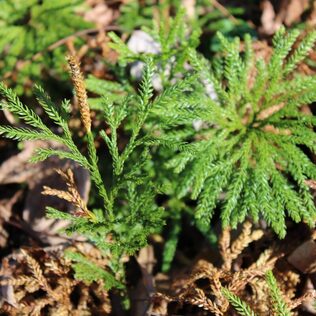 A what now? It's a tree! It's a moss! No, it's Tree Clubmoss....which is actually a fern ally. Confused yet? Let's break it down! Fern allies are a diverse group of seedless (reproduces through spores) plants that are not true ferns. Essentially, these little dudes are plants that, like ferns, spread by producing and releasing spores instead of seeds. But they aren't ferns. Or trees. Or moss. This perennial evergreen, aka 'Dendrolycopodium obscurum', stays under a foot tall and creeps along the ground, usually in forest areas. Paired with our native ferns this gives us some excellent greenery in the middle of winter! In the fall, this plant releases its spores from green, upright, tubular growths, or "clubs"! Sadly, due to...well...humans, this species of plant is considered endangered in many areas. So if you see some growing, leave it be! Fossils tell us that ancient tree clubmosses grew as much as 130 feet tall and 5 feet around long before the dinosaurs reigned. The spores released from this tiny spreader are so oily and water-resistant they have been used in many ways including powders to soothe chafed skin and protect wounds. Large quantities of the spores were also once used to coat pills to keep them from sticking together. In the early days of photography, the spores were used as flash powder. When ignited, the dry, flammable spores would explode in a brilliant flash of light. Janet Douberly is a brilliant flash of light at Downtown Greens. This article was originally published in the November 2023 edition of Front Porch Magazine. www.frontporchfredericksbueg.com
0 Comments
Leave a Reply. |
AuthorWrite something about yourself. No need to be fancy, just an overview. Archives
February 2024
Categories |
 RSS Feed
RSS Feed